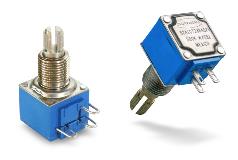
Bourns® Model 82, now and then (1978) |
In the 1970s, Schecter Guitar approached Bourns to design a guitar pot based off of a high-performance potentiometer used in industrial and military markets. Bourns chose its Model 80 as the base product, made modifications to fit a guitar application and sold Schecter hundreds if not thousands of these blue-bodied upscale pots. Unbeknownst to Bourns, Schecter sold some of these potentiometers to repair locations, music stores, etc. In the early 2000s, Bourns began to receive inquiries about replacing these blue pots from many well-known artists and their guitar technicians. This is the story of "Old Blue."
Seymour Duncan on Jeff Beck
The Story of the Tele-Gib
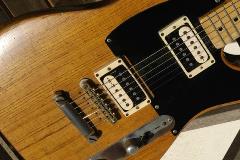
'Tele-Gib' hybrid guitar |
Back in 1974, I was working in London at the Fender Soundhouse where I was doing guitar repair and modifications. One of the benefits of working at Fender was that I had a chance to meet so many great guitarists that rehearsed on the third-floor sound studio.
Nearby was CBS Studios where Jeff was recording the second (unreleased) album with Beck, Bogert and Appice. I decided I would put together a special guitar for Jeff because I had such immense respect for him and his music. I used a Telecaster that was found in 1972 at a music store in Cincinnati, Ohio. The "Tele-Gib" was a hybrid guitar that started out as a butchered '59 Fender Telecaster that originally had a slab rosewood fingerboard. The body was chiseled out badly and had been through some unearthly modifications by the look of it.
It had no pickguard, bridge or other parts that could be used. I worked on repairing the fingerboard and pickguard as quickly as I could so that it could be done before Jeff was done at CBS Studios. I had to rewind a broken pair of old Gibson '59 "Patent Applied For" humbuckers that were damaged when the covers were removed. The pickups were from an old smashed '59 Gibson Flying V that was painted black and once belonged to Lonnie Mack.
It was hard finding the magnet wire needed for winding the coils. I found the wire at a motor repair shop and ended up with two different rolls of wire for winding the coils. I used the heavier gauge to wind the neck pickup because I had only a small amount. I used the finer wire to wind the bridge pickup because I could get extra turns on the bobbins for increased sustain, harmonics and output.
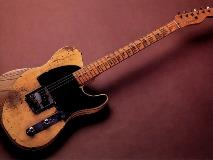
Prior to the makevover |
Over the course of the next several days, I worked on each detail of the guitar so that it would be something unique and worthy of Jeff's talent. Once it was finally ready, I brought Jeff the completed guitar and he seemed impressed by it. I wasn't expecting anything in return at the time – I just wanted to build something that could be put to good use by an amazing guitar player. Later on, Jeff's manager Ralph Baker came in with three guitars in a duffel bag – he said Jeff wanted me to pick any one I wanted. The bag had three bodies and three necks that were disassembled. I choose the Esquire and went to putting it back together.
Even though I wasn't expecting anything in return, back then trades were pretty common and we didn't know the guitars we had would become as valuable as they are now. I made sure to take great care of that guitar and in recent years it has been on display for the public to see at the Rock & Roll Hall of Fame Museum. People have asked me if I would sell it but it's a great piece of history and I want to make sure it is shared with the world.
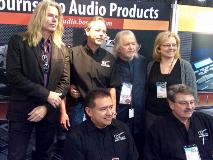
Seymour Duncan at the Bourns NAMM booth |
I'm honored that the "Tele-Gib" that I made for Jeff became a part of the "Blow By Blow" album and that he has described it as a "great guitar, that is really the best of both worlds." He recorded "Cause We've Ended As Lovers" and songs like "Freeway Jam" with it. You can see Jeff playing it on the video "Secret Policeman's Ball." Jeff is my favorite all around guitarist and I can't thank him enough for all the help and friendship he has given me throughout the years. He has many tricks up his sleeve so sit back and listen to what he does! He's the best!
Everybody's been talking about your products and the guitar players come to me, "What do you think?" I say, "You can't beat it." As you know, my number one, I call it a Tele-Gib, I made two of them. I made one for Jeff Beck, which he used on Blow by Blow, and I made one for myself which I've been using for many, many years. Jeff's used it, the Ventures have used it, Ted Nugent's played it, I mean so many people have played this instrument, but I've been using Bourns® pots since probably 19, oh it had to be like '76-'77, I mean a long time, and they are still the perfect pot. I've been using them, I do all the volume swells and tone controls, and they have never let me down.
Seymour W. Duncan
Rhyne Custom Explorer

Jeff Carlisi in 1982 |
This was patterned after Allen Collins' original Gibson explorer and built by Atlanta luthier Jay Rhyne.
- Features: Solid Maple body. Mother of Pearl hawk inlay in fretboard. Brazilian Rosewood pickguard is inlaid in guitar body.
- Frets: Dunlop Jumbo Frets.
- Pickups: DiMarzio Super Distortion at the neck position, DiMarzio Dual Sound at the Bridge position.
- Pots: Bourns
- Use: Primary Studio Guitar, Rhythm guitar on Fantasy Girl and other tracks that needed aggressive sounds.
- Videos: Hold On Loosely, Caught Up in You, Like No Other Night, Wild Eyed - Live from Nassau Coliseum.
Bourns to run...
The Gibson Explorer has always been my dream guitar ever since my good friend Allen Collins of Lynyrd Skynyrd bought one from George Gruhen in 1974 (he paid $4000!). Little did I know at the time that I would own a one off custom-made example which has become a somewhat iconic instrument that I have been associated with over the years.
In 1975, I asked Jay Rhyne, a luthier from Atlanta to build an Explorer replica for me. There was no way I could afford an original so I figured I would settle for a copy. Allen was gracious enough to allow me to trace his Gibson so that Jay would have a template to work with. Six months later, I was playing a beautiful maple Explorer equipped with early DiMarzio pickups. After a few years of touring and recording with 38 Special, I experienced a failure with the volume pot for the bridge pickup. A luthier in Jacksonville, Florida by the name of Allen Chester made the repair and proudly informed me that he had installed a Bourns® pot. It didn't mean that much to me at the time as long as my guitar worked. I soon discovered that not only was the new pot extremely smooth but it also enhanced the tonal characteristics of the instrument. I was a happy camper. I asked Allen what the story was on my new found magic knob and he explained that it was manufactured by a company that made "high-tech" gear for scientific purposes. Whatever!?!?
Fast forward 12 years and Allen replaces my pot with his last Bourns potentiometer and explains to me that he doesn't know if the company is still in business or how to contact them if in fact they still exist. These were the days prior to the Internet. Not to worry….all's well and I'm up and running once again.
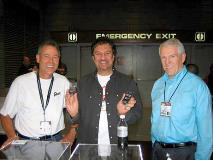
Jeff Carlisi at the Bourns NAMM booth |
Fast forward 20 years and I'm at Summer NAMM 2008 talking to my friend Tommy B, who owns Fat Tone Pickups. He's asking me questions about my Rhyne Explorer all the way down to the pickups and wiring. I tell him about the Bourns pot and asked him not only if he had ever heard of them, but also if he knew of their whereabouts. He casually pointed over a couple of aisles and said..." They're down there on the right". "What!?!?!", I exclaimed! I took off at top speed, rounded the corner and there it was; the Holy Grail glowing like a beacon in the night. I introduced myself to Jim Lawson and told him my story. After he gave me a brief history of the Bourns Company and gave me some samples, we discussed the best way to determine what my guitar was equipped with. I headed home, removed the back plate of my Explorer and determined that my potentiometer was a 500K audio taper model 82.
Fast forward to 2010. I now have all my guitars equipped with Bourns® products. My thanks to all at Bourns for preserving my tone.
Jeff Carlisi
Rick Dufay – Aerosmith
After a live stage mishap while on tour with Aerosmith, Rick sent his Gibson with a broken headstock back to then Gibson's factory in Kalamazoo, MI for repair in the early 80's. Gibson shut down all operations in Kalamazoo around that time and relocated to Nashville, TN. Somewhere during the move, Rick's guitar was forgotten but in fact was moved along with all the other factory equipment to Nashville. Fast forward to 2006, a Gibson employee was searching a storage room full of moved but forgotten items from Kalamazoo and came across a guitar case. He opened the case and found a guitar with a broken headstock and a business card with Rick's name on it. He reached out to a contact on Rick's webpage and finally reached Rick who could not believe his ears, his old axe was not lost as he had thought. He told the Gibson employee to fix it and send it back when it was completed.
Some time later, the Gibson employee decided to work on Rick's guitar, opened up the electronics cavity and came upon these "blue pots", something he had seen before in other vintage instruments returned for repair work. He decided to find out more about these pots and their source. After contacting Bourns, Gibson set about on a plan to include an updated version of these pots and introduced them in the 2008 Les Paul Standard model.
Back to Rick's career..
(Born Richard Marc Dufay, February 19, 1952 in Paris, France), Rick played guitar in Aerosmith between the departure of Brad Whitford in 1981 and his subsequent rejoining (along with Joe Perry) in 1984. Before joining the band, Rick released an album called Tender Loving Abuse. That album was produced by Aerosmith knobsman Jack Douglas who also recommended him to Steven Tyler as Whitford's replacement. Dufay can be heard on parts of Aerosmith's 1982 Rock in a Hard Place album as well being seen in the video for "Lightning Strikes". Dufay was also apparently a stabilizing force for the band on the road, describing himself in Behind The Music: Aerosmith as caring for Tyler during his lowest points of addiction and depression, and famously suggesting to the singer he reunite with Whitford and Perry for the sake of Aerosmith overall, and Tyler in particular. It was for that reason, Joe Perry thanked Dufay for "committing career suicide" during Aerosmith's Rock and Roll Hall of Fame acceptance speech in 2001. Since leaving Aerosmith, Rick has been engaged in various projects, including the band Blue By Nature featuring vocalist Karen Lawrence.
Ray Jennings – Atlanta band leader
Here's the deal. He has an original (and he is the original owner) 1973 Les Paul Custom black beauty, 2 PUPs. After owning it for a couple of years, a buddy of his told him he should upgrade his pots, recommended ours and somehow got his hands on these pots we made years ago for Schecter. He says they were "expensive", priced at $6 each in 1978. Now his guitar with case in 1973 was $520! Ray contacted Bourns inquiring about replacements for his pots after 40 years!
From: Raymond Jennings
Sent: Friday, November 11, 2016 11:54 AM
To: Jim Lawson
Subject: RE: Picture
Good Morning,
I received the package and my other guitar player and I wore the shirts and hat last Saturday at a gig. I've had several of my guitar buddies ask about Bourns controls and I hope I represented you well. I have put your POTS in all my guitars and they will probably out live me. My guitars have been Bourn again!
I can't tell you how much I appreciate your generosity and will tell everyone who will listen about not putting every day "These will do the same" controls, but step up to a superior product, don't you, your tone and your guitar deserve the best? You don't have to live with scratchy POTS!
Jeeze I feel like a superstar sales man, just not territory.
One of the biggest problems with changing controls is many guitar players have trouble just tuning the guitar much less operating a soldering iron. Perhaps if you could make the change stewped proof, ie a kit with big colorful drawings and a heat sink for the caps. And a very detailed video showing take this wire off and put it here, take the next wire off and put it here plug the guitar into the amp and try each control before going to the next. Probably need to include bandaids and salve for the iron burns.
Peace Out,:-)
Ray Jennings
1973 Les Paul
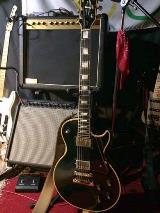
1973 Les Paul |
|
|
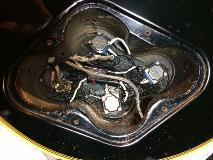
Old Blues |
|
Adrian Vandenberg – Vandenberg, White Snake lead guitarist
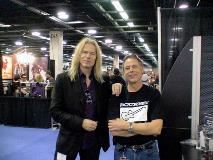
Adrian Vandenberg |
I did a guitar interview with Michael from Gitarre & Bass Magazin, which is a leading German guitar player's magazine... The Germans are really thorough in their tests and stuff, and he gave the guitar I think a 10-minus, or something, out of 10. So, I asked him, "Well what is the minus about?" You know, I was curious. He said, well it would be just an extra little hit if you guys put a Bourns® pot meter in there. There was a bell ringing in my head, I thought. I thought I was always using those. You know, I'm not a guy who sits there with a solder iron in the back of his guitars anymore. Usually, I have a tech for that. I talked to my former tech a couple of days later on the phone out of coincidence. I said, "We were always using Bourns stuff." "Yeah, yeah right." So, I called the guys at Aristides and said we got a 10- and we've got to change that ‘cause we want the best of the best.
Adrian Vandenberg
Will Kelly – Vintage Guitar Columnist, Master Luthier
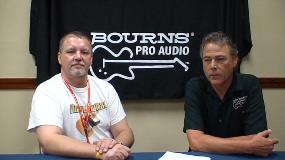
Wil Kelly |
I would NEVER recommend nor use any thing else but Bourns ...period. I've personally introduced such well known artists as Joe Bonamassa, John Oates, Nancy Wilson, Greg Martin, Doug Phelps, Johnny Hiland, Ryan Tedder, Steve Winwood, Hershel Yatovitz, Robbie Calvo, Rick Vito and many others to Bourns. Your pots are in guitars all over the world, on stages and in recording studios worldwide as a result... I'm proud to be associated with your company in some small way.
Will
Lee Dickson – Eric Clapton's Guitar Tech for 30 years
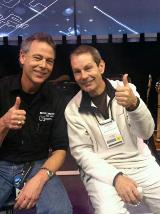
Lee Dickson |
I'm here today to tell you a few things. I discovered these guys, Bourns Audio, and they make the best guitar pots. You know you look at guitars, everyone buys expensive guitars. They pay a fortune for their guitars with the best pickups, the best wiring, the best inlay material, but the pots you know, they've never really changed. And through a buddy of mine in North Carolina who builds his own guitars, he turned me on to Bourns. I've met them and I'm here today to try to tell you a bit about their products. But they do have an amazing selection of electronics stuff but if you guys ever have trouble with scratchy pots or a pot that dies between 1 and 2, I'd highly recommend these guys. As far as doing the job, I don't think there is a better guitar pot out there than these. They are just so smooth. I would advise anyone who is upgrading or making their own guitar to start here and use Bourns.
Lee Dickson